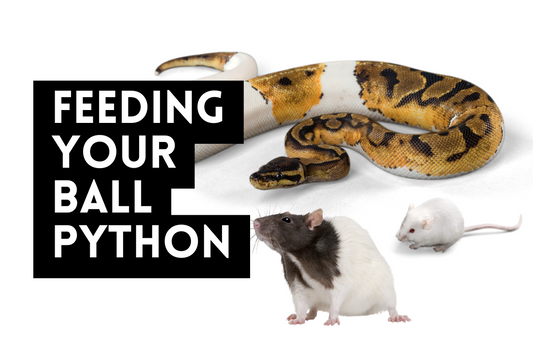What Do Ball Pythons Eat? A complete guide to their diet
Share
The Ultimate Guide to Ball Python Feeding: Exploring Different Feeder Options
Ball pythons, with their docile nature and fascinating patterns, have slithered their way into the hearts of reptile enthusiasts worldwide. A crucial aspect of their care involves their diet, which can significantly impact their health and longevity. Among the myriad of feeder options available, African Soft Fur rats (ASF), Norwegian rats, and the choice between live and frozen/thawed feeders present a variety of benefits and drawbacks. In the wild, ball pythons feast on a variety of prey, adapting to what's available in their African habitat. This diet primarily consists of small mammals. For captive ball pythons, owners have several feeder options, including African soft furs, Norwegian rats, and both live and frozen-thawed prey. Each option comes with its own set of benefits and drawbacks, making it essential for owners to make an informed decision.
African Soft Furs: The Optimal Choice
Frozen ASF rats are not just another feeder option; they are a game-changer for ball python nutrition. Native to Africa, ASF rats are the perfect feeder choice for ball python owners. Sized between mice and rats, ASFs are a lean source of high protein and calories, yet low in fat. This nutritional profile makes them an exceptional choice, especially when compared to the more commonly used rats and mice.
ASF rats pack more calories and protein per gram, offering a more efficient and beneficial meal to your ball python. This makes them particularly valuable for breeders looking to get their snakes up to weight for the breeding season or aiding in recovery post-breeding. For those managing picky eaters, introducing ASF can be the key to encouraging regular feeding behaviors.
Benefits:
- Nutritional Value: ASFs offer a balanced diet, closely mirroring what ball pythons would eat in the wild. This can lead to better digestion and overall health. Better digestion means small poos in our experience.
- Behavioral Enrichment: Feeding ASFs can stimulate the natural hunting behaviors of ball pythons, promoting mental and physical activity.
- Reduced Obesity Risk: ASFs tend to be leaner than some other rodent options, helping prevent obesity in captive pythons.
Drawbacks:
- Availability: ASFs can be harder to find and cost slightly more than more common feeder rodents, such as mice or Norwegian rats. However we're firm believers in producing quality animals and that starts with what they're eating.
- Feeding Live: Some owners may be uncomfortable with or unable to feed live prey due to ethical concerns. This is where frozen-thawed ASFs really shine. Frozen-thawed African soft furs give your ball python the best of both worlds, their natural prey offered in a safe and convenient manner.
At Ghost Constrictors, we recommend feeding your ball python a prey item that is approximately 10-15% of your snake's body weight. To assist in selecting the proper sized feeder, a reference chart is available, ensuring your pet receives the nutrition it needs without the guesswork.
Furthermore, all Ghost Constrictors African Soft Furs are fed an organic diet, guaranteeing that your snake consumes only the highest quality food. Our frozen products are vacuum sealed for freshness and safety, providing your snakes, amphibians, or birds of prey with a premium feeding experience every time.
Norwegian Rats: A Common Alternative
Norwegian rats are another popular feeder choice for ball python owners. Larger than ASF and mice, they can be a suitable option for adult pythons. However, their higher fat content compared to ASF rats means they might not be the best choice for every meal, especially for snakes prone to obesity.
Benefits:
- Accessibility: Norwegian rats are easy to find in pet stores or from breeders.
- Size Variety: They are available in sizes that can accommodate ball pythons as they grow.
Drawbacks:
- Nutritional Differences: They may not provide the same nutritional balance as ASFs, potentially leading to dietary deficiencies or obesity.
- Behavioral Concerns: Feeding exclusively on rats can sometimes lead to finicky eating habits, with pythons refusing other types of prey.
Live vs. Frozen/Thawed Feeders
The debate between offering live versus frozen/thawed prey is ongoing among reptile enthusiasts. Live feeders can stimulate a ball python's natural hunting instincts, providing mental and physical enrichment. However, this option carries the risk of injury to the snake from prey defense mechanisms.
Live Prey:
- Pros: Can encourage natural hunting behaviors and ensure the prey is fresh.
- Cons: There's a risk of injury to the snake from prey defense mechanisms. Ethical and personal issues may also arise.
Frozen/thawed feeders, on the other hand, offer a safer alternative, eliminating the risk of harm to your pet. This method also allows for more convenient storage and the ability to maintain a steady supply of feeders. It's essential to ensure that thawed feeders are warmed to the appropriate temperature to encourage feeding.
Frozen-Thawed Prey:
- Pros: Minimizes the risk of injury to the snake, is more convenient, and eliminates ethical concerns associated with live feeding.
- Cons: Requires proper thawing techniques to ensure safety and palatability. Some snakes may initially refuse frozen-thawed prey, requiring a period of adjustment.
Conclusion
When considering the health and well-being of your ball python, the choice of feeder is paramount. African Soft Furs, with their optimal nutritional profile emerge as the best option for these reptiles. By choosing ASF, especially from reputable sources like Ghost Constrictors that guarantee organic feeding and safe packaging, you're ensuring your ball python receives the best possible diet.
Remember, the key to a healthy ball python lies not just in the right feeder choice but also in understanding and meeting the unique needs of your pet. Whether you opt for ASF rats, Norwegian rats, or a combination of feeder types, always prioritize the health and safety of your ball python and only buy from a reputable source. Ultimately, the best choice depends on the individual needs of the python and the capabilities of the owner to provide a diet that is both nutritious and ethically sourced.
Notes:
- For detailed studies and expert opinions, we encourage you to consult veterinary resources and scientific publications on reptile care.
This comprehensive approach to ball python feeding ensures your pet thrives, reflecting the care and commitment you bring to their well-being.












